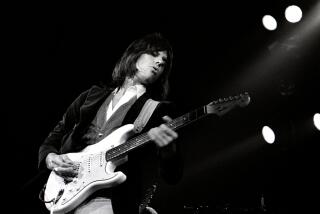Gibson’s pick: a digital guitar
- Share via
NASHVILLE, Tenn. — As Gibson Guitar Corp. launches a new digital model, company head Henry Juszkiewicz can close his eyes and almost hear the music.
“The defining moment will be when a certain lick in a popular song is out there, and it can’t be done with anything else but a digital guitar,” Juszkiewicz says. “It only takes one example to really inspire people.”
That, Juszkiewicz hopes, will usher in the age of the digital guitar -- much the same way as the Beatles and Rolling Stones inspired a generation of young people to pick up a standard electric guitar in the 1960s.
“It opens a whole new palette of possibilities,” Juszkiewicz says. “It’s a little bit like hearing stereo as opposed to mono.”
Juszkiewicz knows guitars. A Harvard MBA who played in garage rock bands, he bought Gibson with two buddies for $5 million when it was struggling in 1986 and built it into a company with annual sales of $250 million in 2001. At one point, Gibson had fewer than 60 employees. Today, Juszkiewicz says it has 3,000 worldwide.
The advantages of the digital guitar come down to sound and control. For 70 years, the electric guitar pickup has translated string vibrations into an electrical signal fed to an amplifier. The player can control the tone and volume, but output is limited to a mono or stereo signal. The signal itself is noisy by today’s standards, and stray frequencies often cause an annoying hum.
“Some of the guitar pickups popular today go back to the 1920s,” Juszkiewicz said. “We have not changed a lot in terms of the instrument.”
The digital guitar uses computer chips to clean up the signal -- Juszkiewicz describes the new sound as traditional but “on steroids.” It also lets the player control the sound of each string. For example, the guitarist can have a heavy metal crunch on the low strings, medium distortion on the middle strings and a clean sound on the high strings.
“You’ll be able to record all these different sounds and textures. It’s unbelievable, I think,” said Dave Cleveland, a Nashville session guitarist who planned to buy one of the new instruments.
Cleveland said technology already exists to do some of the same things as the digital guitar, but it’s bulky, inconvenient and limited. “With this, ... you can monitor everything through the guitar. It’s like having a mini recording studio,” he said.
But some question whether guitar players, by and large a picky lot who are attached to their vintage amplifiers and instruments, will want the bells and whistles.
“I agree that there are certain things it can do,” said George Gruhn, owner of Gruhn Guitars in Nashville. “But what it comes down to is people want an electric guitar for soul. I don’t see it taking over the world.... All of the newfangled stuff doesn’t give the tonality that guitar players are looking for.”
Gibson’s most popular guitar, the Les Paul, retails at about $1,300. The digital guitar will cost $1,000 to $1,500 more than a standard model.
Juszkiewicz acknowledges that consumers might be resistant at first, but Gibson’s engineers worked hard, he said, to make the digital guitar look and feel the same as a traditional guitar and be compatible with standard equipment.
